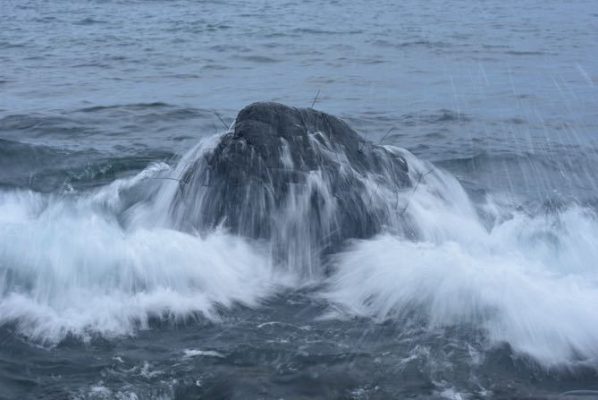
Have you ever imagined what it would like to be something other than human—a hawk gliding through the air or a monkey swinging from a tree? What about reincarnating yourself as a stone? It’s probably not top of your list of shape-shifting choices, but wouldn’t it be interesting nonetheless? Ever since Paleolithic man grasped his first piece of flint, humans have been on a constant quest to extend our abilities, sharpen our senses—to stretch and enlarge our realms of perception. In their project “Stone” Korean artists Shin Seung Back and Kim Yong Hun examine this persistent human interest in “self-improvement” through technological prostheses—applying this theory of “perception extension” to something as inert as a volcanic rock.

Ullengdo, a volcanic island in Korea
As humans we often imagine ourselves doing grand things as “masters of the universe”, but what if we were rooted to one spot or eternity. Why not take a vacation from our role as omnipotent beings and become an inert object, try on a different skin, to understand what it is like to be something other than human?
Sitting in this vibrating structure, we might begin to imagine, what does it feel like for other organisms to live in the era of the “Anthropocene”—watching mutely as human-powered capitalism slowly unravels the intricate, sophisticated systems of nature, which are a product of millions of years of evolution.
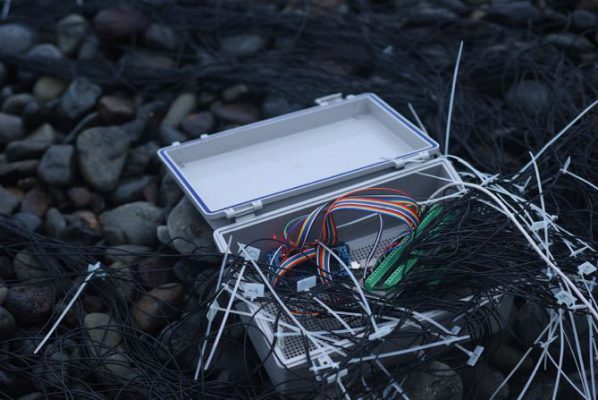
“Stone”, water sensors, micro controller, solenoids, computer, projector, speakers and wooden panels, 2017.
The collective, Shinseungback Kimyonghun, has long been interested in these boundaries and definitions of “humanness” as seen through their many experiments with AI and facial recognition software. For instance, “Cat or Human" explores the failure of AI to accurately sort human and cat faces—to computers cats and humans are often indistinguishable. Another work “Animal Classifier”, creates a whole new taxonomy for animal classification using categories such as “belonging to the emperor”, “embalmed”, “drawn with a very fine camel hair brush” and “having just broken the water pitcher”. Poking fun at the scientific method of classification (such as the Linnean Taxonomic Hierarchy steeped in a culture of man-made scientific rationalism), they present a series of LCD screens in bell jars displaying a variety of relevant specimen culled from a google image search—replacing the learned scientist with image recognition software.
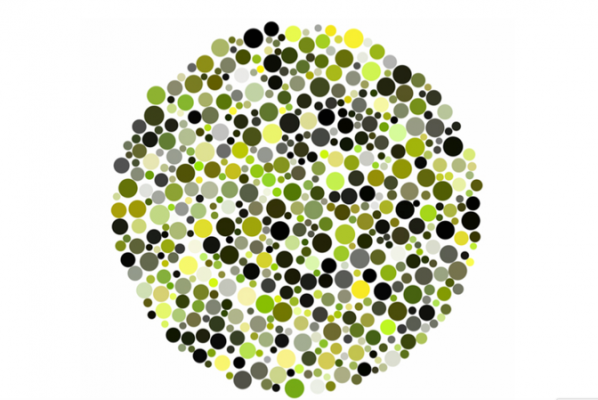
FADTCHA (test 1)”, 2013, Book, 28 pages, color, ENG-KOR, 20.5 cm x 20.5 cm
In a sense, we can look at their practice as a character sketch of a computer. How do computers analyze visual data —"FADTCHA". What kind of alternate languages do they use—The God's Script. How can we can we avoid communicating with them—CAPTCHA TWEET. And will they become our enemies—Aposematic Jacket. Whether we like it or not, our lives are as intertwined with machines as they are with nature and the animal kingdom and as these boundaries blur we start to wonder how do we even define our species—do we lean more towards animal or machine?
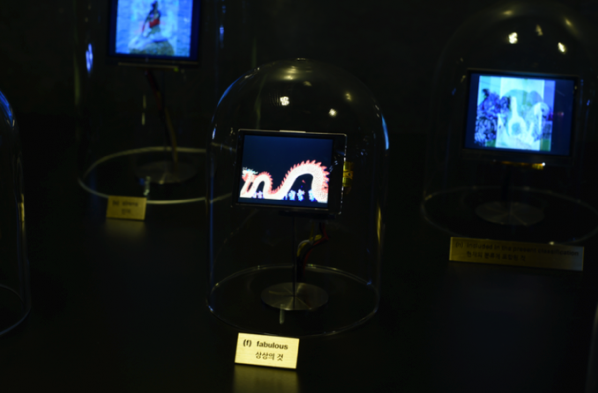
“Animal Classifier”, 2016, TensorFlow, Inception-v3, online images, 14 Raspberry PIs, 14 engraved metal plates, 14 glass domes and 14 monitors
As Elizabeth Oriel so eloquently writes in her essay “Whom Would Animals Designate as “Persons”:
“Are humans mechanistic and should these qualities of supreme intelligence, reliability, and controllability become the hallmark of our humanity, the features we are most proud of? Or are the connections to our ancestors and roots, our honoring of these relationships and our dependence on all of the earth’s systems be our defining attribute, what we honor most?”
(Oriel, Elizabeth, “Whom Would Animals Designate as “Persons”? On Avoiding Anthropocentrism and Including Others”, Journal of Evolution and Technology, Vol. 24 Issue 3 Sept 2014, p 44.)
There is a debate occurring on different strands of the spectrum of posthumism; the first occurs in the field of animal studies—“anthropo-insistence”—that animals should be classified as human. There have of course been many cases to grant personhood to apes, using the definitions of cognizance, empathy and so on but also to “living systems” such as the Whanganui River in New Zealand which was recently recognized as an integrated living whole and was appointed two official guardians: one from the "iwi" indigenous people and one from the New Zealand government.
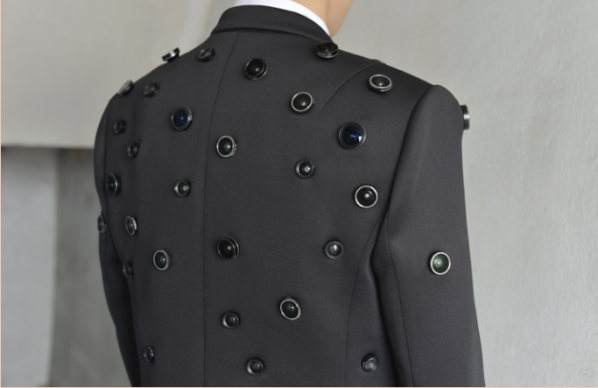
“Aposematic Jacket”, 2014, lens, Raspberry Pi, camera, Wi-Fi module, battery pack and fabric, 15 x 60 x 70 cm.
At the same time, the European Parliament is currently drafting laws to ensure the personhood of robots, in the legal sense that corporations are also considered “persons”, which represents the other side of the debate.
So what does it really mean to be human? Sentience, consciousness, emotions? Many animals have been shown to experience these things. Perhaps then, it is logic and objectivity, but then we find ourselves in the same camp as machines and robots. We have traditionally defined our humanness through our dominance over other species, (i.e. we are smarter than they are), but what happens when we are outpaced by robots—a superior species far more intelligent, capable and logical that doesn’t experience cell death and heart disease not to mention mental illness and grief? What happens when the masters are dethroned; now with no purpose, nothing to do all day but sit and watch the waves wash up upon the shore.
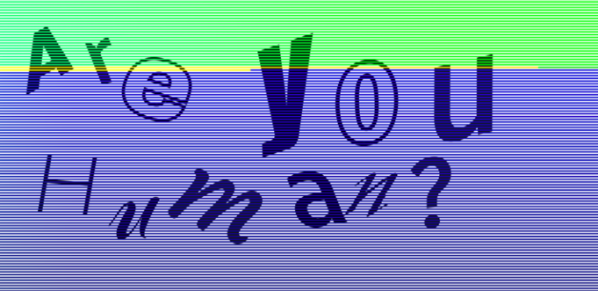
“CAPTCHA Tweet”, 2013, Web Application (www.captchatweet.com).
About the artist
Shinseungback Kimyonghun is a Seoul-based artistic duo consisting of Shin Seung Back and Kim Yong Hun. Their collaborative practice explores technology’s impact on humanity. Shin Seung Back studied Computer Science in Yonsei University and Kim Yong Hun completed a Bachelor of Visual Arts at the Sydney College of the Arts. They met while studying at the Graduate School of Culture Technology in KAIST and after completing Masters in Science and Engineering, they started to work as Shinseungback Kimyonghun in 2012. Their work has been presented extensively, including the Ars Electronica Festival, Vienna Biennale, the ZKM and MMCA Korea.
About the curator
Rebecca Catching is the Executive Director of the contemporary art platform Assembly Line Project and co-founder of the online Chinese art magazine Ran Dian. During the past 15 years in China, she has worked as a magazine editor, art critic, gallery director, and museum curator. Rebecca’s research and curatorial interests include the continuing dialogue between Buddhist/Daoist thought and contemporary Chinese art (“Learning from the Literati” series), the field of social practice as (Assembly Line Project Studio) and the topic of posthumanism in the context of East Asian new media art practice (“Foreign Bodies”).
About the exhibition
Dates: 2017.3.31—2017.4.28 10:30am-6:30pm M-F
Opening and Artist Talk: March 31, 2017, 7-9:00pm
Venue: Department for Culture and Education of the German Consulate General in Shanghai
Curated by Rebecca Catching
Address: Room 101 Cross Tower, 318 Fuzhou Lu, near Shandong Zhong Lu, Huangpu, Shanghai
Courtesy of the artist and Department for Culture and Education of the German Consulate General in Shanghai.




























